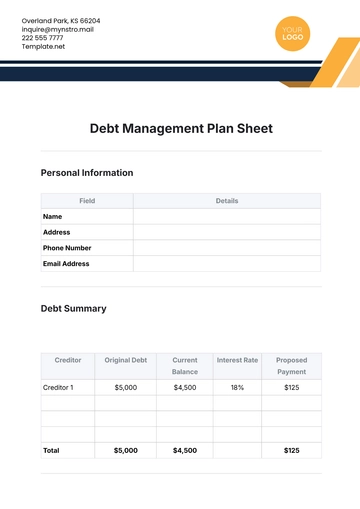Free Simple Financial Investment Strategy Plan

1. Executive Summary
This Financial Investment Strategy Plan outlines a diversified investment approach designed to achieve long-term capital growth while managing risk. The plan targets a 7% annual return over the next ten years, balancing a mix of asset classes to optimize performance.
2. Investment Goals and Objectives
Primary Goal: Achieve long-term capital growth of 7% annually.
Secondary Goal: Generate passive income of $10,000 per year by year five through dividends and interest.
Time Horizon: 10 years, with regular reviews every six months.
3. Market Analysis
Current economic conditions indicate moderate growth with inflation rates stabilizing around 2%. The equity market is projected to deliver robust returns, while interest rates on bonds are likely to remain low. Emerging markets show potential for higher growth, albeit with increased volatility.
4. Asset Allocation Strategy
Equities: 60% (40% in U.S. stocks, 20% in international stocks)
Fixed Income: 30% (government bonds, corporate bonds)
Real Estate: 5% (REITs for income generation)
Alternative Investments: 5% (commodities and hedge funds for diversification)
5. Risk Assessment and Management
Market Risk: Diversify across asset classes to mitigate volatility.
Interest Rate Risk: Maintain a laddered bond portfolio to manage interest rate fluctuations.
Liquidity Risk: Ensure at least 10% of the portfolio is in liquid assets.
6. Investment Selection Criteria
Equities: Focus on companies with strong fundamentals, competitive advantages, and a history of dividend growth.
Bonds: Select bonds with investment-grade ratings and manageable maturities.
REITs: Look for diversified real estate portfolios with strong cash flow.
7. Monitoring and Review Process
Performance Metrics: Monitor portfolio returns against benchmarks every quarter.
Review Meetings: Conduct biannual reviews to adjust the strategy based on market conditions and performance.
8. Implementation Plan
Initial Investment: Allocate funds according to the asset allocation strategy.
Investment Platforms: Utilize a mix of brokerage accounts and retirement accounts for tax efficiency.
Regular Contributions: Set up automatic monthly contributions to maintain investment levels.
9. Tax Considerations
Utilize tax-advantaged accounts for income-generating investments.
Consider tax-loss harvesting strategies to offset capital gains.
10. Conclusion and Recommendations
This Financial Investment Strategy Plan provides a clear roadmap for achieving investment goals. Regular monitoring and adjustments will ensure alignment with changing market conditions and personal financial objectives. It is recommended to stay informed about market trends and consider professional advice for complex investment decisions.
- 100% Customizable, free editor
- Access 1 Million+ Templates, photo’s & graphics
- Download or share as a template
- Click and replace photos, graphics, text, backgrounds
- Resize, crop, AI write & more
- Access advanced editor
You may also like
- Finance Plan
- Construction Plan
- Sales Plan
- Development Plan
- Career Plan
- Budget Plan
- HR Plan
- Education Plan
- Transition Plan
- Work Plan
- Training Plan
- Communication Plan
- Operation Plan
- Health And Safety Plan
- Strategy Plan
- Professional Development Plan
- Advertising Plan
- Risk Management Plan
- Restaurant Plan
- School Plan
- Nursing Home Patient Care Plan
- Nursing Care Plan
- Plan Event
- Startup Plan
- Social Media Plan
- Staffing Plan
- Annual Plan
- Content Plan
- Payment Plan
- Implementation Plan
- Hotel Plan
- Workout Plan
- Accounting Plan
- Campaign Plan
- Essay Plan
- 30 60 90 Day Plan
- Research Plan
- Recruitment Plan
- 90 Day Plan
- Quarterly Plan
- Emergency Plan
- 5 Year Plan
- Gym Plan
- Personal Plan
- IT and Software Plan
- Treatment Plan
- Real Estate Plan
- Law Firm Plan
- Healthcare Plan
- Improvement Plan
- Media Plan
- 5 Year Business Plan
- Learning Plan
- Marketing Campaign Plan
- Travel Agency Plan
- Cleaning Services Plan
- Interior Design Plan
- Performance Plan
- PR Plan
- Birth Plan
- Life Plan
- SEO Plan
- Disaster Recovery Plan
- Continuity Plan
- Launch Plan
- Legal Plan
- Behavior Plan
- Performance Improvement Plan
- Salon Plan
- Security Plan
- Security Management Plan
- Employee Development Plan
- Quality Plan
- Service Improvement Plan
- Growth Plan
- Incident Response Plan
- Basketball Plan
- Emergency Action Plan
- Product Launch Plan
- Spa Plan
- Employee Training Plan
- Data Analysis Plan
- Employee Action Plan
- Territory Plan
- Audit Plan
- Classroom Plan
- Activity Plan
- Parenting Plan
- Care Plan
- Project Execution Plan
- Exercise Plan
- Internship Plan
- Software Development Plan
- Continuous Improvement Plan
- Leave Plan
- 90 Day Sales Plan
- Advertising Agency Plan
- Employee Transition Plan
- Smart Action Plan
- Workplace Safety Plan
- Behavior Change Plan
- Contingency Plan
- Continuity of Operations Plan
- Health Plan
- Quality Control Plan
- Self Plan
- Sports Development Plan
- Change Management Plan
- Ecommerce Plan
- Personal Financial Plan
- Process Improvement Plan
- 30-60-90 Day Sales Plan
- Crisis Management Plan
- Engagement Plan
- Execution Plan
- Pandemic Plan
- Quality Assurance Plan
- Service Continuity Plan
- Agile Project Plan
- Fundraising Plan
- Job Transition Plan
- Asset Maintenance Plan
- Maintenance Plan
- Software Test Plan
- Staff Training and Development Plan
- 3 Year Plan
- Brand Activation Plan
- Release Plan
- Resource Plan
- Risk Mitigation Plan
- Teacher Plan
- 30 60 90 Day Plan for New Manager
- Food Safety Plan
- Food Truck Plan
- Hiring Plan
- Quality Management Plan
- Wellness Plan
- Behavior Intervention Plan
- Bonus Plan
- Investment Plan
- Maternity Leave Plan
- Pandemic Response Plan
- Succession Planning
- Coaching Plan
- Configuration Management Plan
- Remote Work Plan
- Self Care Plan
- Teaching Plan
- 100-Day Plan
- HACCP Plan
- Student Plan
- Sustainability Plan
- 30 60 90 Day Plan for Interview
- Access Plan
- Site Specific Safety Plan





























